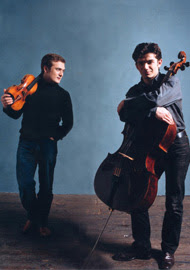 I don’t know if orchestras get a two-for-one special if they invite the Capuçon brothers – but what a good occasion to hear Brahms’ Double Concerto, one way or the other. Hearing this late Brahms work (when he composed it, Arturo Toscanini already had a conducting career under way, Wilhelm Backhaus grown his first teeth, and Mahler composed his First Symphony) with the NSO under Leonard Slatkin this Thursday. It is a concerto much more prominent on the record shelves than in the concert hall, which is a shame, because it is easily Brahms’ finest concerto and a delight to hear when played as well as by the two shamelessly young French musicians. Who could be more in greater rapport together than two brothers, musically joined at the hip.
I don’t know if orchestras get a two-for-one special if they invite the Capuçon brothers – but what a good occasion to hear Brahms’ Double Concerto, one way or the other. Hearing this late Brahms work (when he composed it, Arturo Toscanini already had a conducting career under way, Wilhelm Backhaus grown his first teeth, and Mahler composed his First Symphony) with the NSO under Leonard Slatkin this Thursday. It is a concerto much more prominent on the record shelves than in the concert hall, which is a shame, because it is easily Brahms’ finest concerto and a delight to hear when played as well as by the two shamelessly young French musicians. Who could be more in greater rapport together than two brothers, musically joined at the hip.Renaud and Gautier (violin and cello, respectively) are both fascinating soloists in their own right – and in the Brahms their individual qualities came together for more than the sum of its parts, even. Their affinity with the work and each other was immediately audible (just how important that is can be heard on the famous RCA recording of Heifetz and Piatigorsky where the former drags the latter speedily around the work, producing fireworks while neglecting the whole). The opening on the cello was spot-on, in gloriously burnished sound. A brisk, but never hasty, performance displayed the cello as the “more equal” of the instruments – but hardly for any lack of engagement, skill, or enthusiasm on Renaud Capuçon’s searing part. The orchestra performed with equal engagement and subtle touches. The very well honed decrescendo toward the end of the third movement seemed like an exclamation point to that effect.
J. Adams, Harmonielehre, De Waart/SFSO J.Brahms, Double Concerto, Clarinet Quintet, Capucon Bros. / Myung-Whun Chung / Mahler Youth Orchestra |
Slatkin is predictable in his talks – but predictably good in connecting to the audience members that he needs to address. His approach softens the fears of exposure to the unknown and makes the casual listener’s ears more amenable to strange sounds they would not usually tolerate. Hearing Harmonielehre live adds the necessary layer of ‘triumphant glory-noise’ that an orchestral piece like that needs in order to appeal: on record and without the introduction it would likely make fewer friends.
Although Maestro Slatkin assured me (in an interview for WGMS that got lost in the DC's general classical radio station upheaval) somewhat disingenuously that he plays and conducts every piece of music with the same enthusiasm and dedication, the impression that he dedicates himself more – and more successfully – to those works he has a great affinity for and desire to propagate to audiences remains as strong as ever and was only furthered by this very detailed, passionate, and exemplarily played performance. Instead of a work to be avoided (or endured, for Brahms’ sake), Slatkin and the NSO turned it into a season-highlight, no matter how strong one may think the composition itself to be. (Calling it one of the great masterpieces “not just of our time but all times” as Slatkin raved might have been overshooting a bit, but a potentially marvelous piece it is by all means – and certainly was on Thursday.) Along with Adams’ Violin Concerto, Short Ride..., Shaker Loops and El Niño it is among the finest, most accessible of his works… swelling and ebbing rousingly, hinting at minimalism only faintly in the first movement.
Tim Page, NSO Pieces Together John Adams's Patchwork (Washington Post, February 16) Tim Smith, NSO scores big with minimalism (Baltimore Sun, February 16) Charles T. Downey, DCist Goes to the Symphony (DCist, February 20) |
No matter the road conditions, this concert is very much worth attending – there will be plenty space available for the two remaining performances Friday at 7PM and Saturday at 8PM.